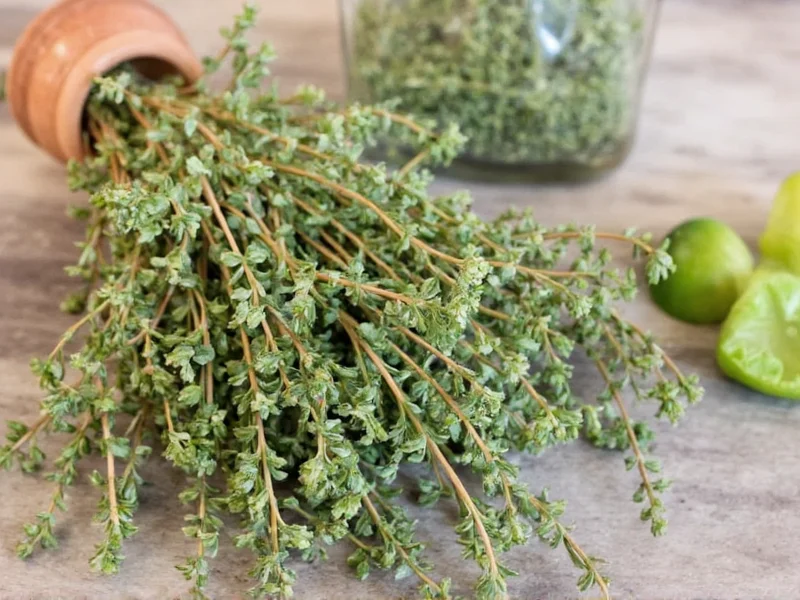Drying fresh thyme preserves its aromatic flavor for year-round cooking while concentrating its essential oils. Whether you've harvested from your garden or bought a surplus at the market, proper drying techniques ensure you maintain the herb's culinary value without losing potency. This comprehensive guide details proven methods that home cooks and gardening enthusiasts can implement with basic kitchen equipment.
Preparing Fresh Thyme for Drying
Before drying fresh thyme, proper preparation significantly impacts the final quality. Start by selecting vibrant green sprigs with no yellowing or wilting. Gently rinse thyme under cool water to remove dirt and insects, then pat completely dry with a clean kitchen towel—any moisture remaining will encourage mold during the drying process.
For optimal results when learning how to dry fresh thyme, avoid washing immediately before drying. Instead, allow washed thyme to air dry for 30 minutes on a wire rack. Remove leaves from thick stems if you plan to use a dehydrator, but keep sprigs intact for air drying methods. Never use damaged or discolored leaves, as these will compromise your entire batch.
Air Drying Fresh Thyme: The Traditional Method
Air drying preserves the most delicate flavors of thyme but requires patience. This best way to dry fresh thyme for flavor retention involves simple steps:
- Gather 5-6 thyme sprigs into a small bundle
- Secure stems with twine or a rubber band (not too tight)
- Hang upside down in a dark, warm, well-ventilated area
- Maintain consistent temperature between 60-80°F (15-27°C)
- Allow 7-14 days for complete drying
This method works particularly well for those wondering how to preserve fresh thyme without special equipment. The darkness prevents color loss while good airflow prevents mold. Check daily after the first week—properly dried thyme will feel brittle and crumble when touched.
Oven Drying: Quick Preservation Technique
When time is limited, oven drying fresh thyme delivers reliable results in hours rather than days. This approach to drying thyme in oven requires careful temperature control:
- Preheat oven to its lowest setting (ideally 170°F/75°C)
- Spread thyme in single layer on parchment-lined baking sheet
- Place oven door slightly ajar to allow moisture escape
- Dry for 1-2 hours, checking every 20 minutes
- Remove when leaves crumble easily between fingers
Many home cooks prefer this method when learning how to dry fresh thyme quickly for immediate cooking needs. Avoid higher temperatures that destroy essential oils—thyme should never brown during drying. For thicker stems, flip sprigs halfway through the process to ensure even drying.
Using a Food Dehydrator for Perfect Results
For consistent, high-quality dried thyme, a food dehydrator offers precise control. This method for drying thyme without losing flavor works efficiently:
| Dehydrator Setting | Time Required | Result Quality |
|---|---|---|
| 95°F (35°C) | 3-4 hours | Best flavor retention |
| 105°F (40°C) | 2-3 hours | Good balance of speed and quality |
| 125°F (52°C) | 1-2 hours | Fast but slightly reduced aroma |
Arrange thyme in single layers on dehydrator trays, ensuring good air circulation. Check hourly after the first 90 minutes. The ideal temperature range for drying thyme without losing flavor is 95-105°F (35-40°C). This method produces uniformly dried thyme with maximum essential oil retention.
Determining When Thyme Is Fully Dried
Knowing when is thyme fully dried prevents premature storage that leads to mold. Properly dried thyme exhibits these characteristics:
- Leaves crumble easily when pinched between fingers
- No visible moisture when inspected closely
- Stems snap rather than bend
- Herb retains green color (not brown or yellow)
- No flexible parts remain on the sprig
Many beginners make the mistake of storing thyme too soon. If any part feels leathery or flexible, continue drying. Properly dried thyme should have a crisp texture throughout—this ensures how long does dried thyme last will be maximized.
Storing Dried Thyme for Maximum Shelf Life
Proper storage determines how long does dried thyme last in your pantry. Follow these steps for optimal preservation:
- Completely cool dried thyme before storage (15-20 minutes)
- Remove leaves from stems by rubbing between palms
- Sift through a fine mesh strainer to remove debris
- Store in airtight glass containers with tight-sealing lids
- Keep in a cool, dark cupboard away from heat sources
- Label containers with date of drying
When storing dried thyme properly, it maintains peak flavor for 6-12 months. Exposure to light, heat, or moisture significantly reduces shelf life. For extended storage, consider vacuum sealing portions and keeping them in the freezer—this method preserves fresh thyme to dried thyme conversion potency for up to 18 months.
Using Dried Thyme in Cooking
Understanding fresh thyme to dried thyme conversion ensures proper seasoning. Dried thyme is more concentrated, so use this ratio:
- 1 teaspoon dried thyme = 1 tablespoon fresh thyme
- Add dried thyme early in cooking to rehydrate and release flavors
- Use in soups, stews, roasted meats, and tomato-based sauces
- Grind between palms before adding to dishes for better dispersion
Dried thyme works best in dishes with longer cooking times, allowing its flavors to fully develop. For finishing touches, consider mixing a small amount of dried thyme with olive oil to create a flavorful infusion that better approximates fresh herb characteristics.
Common Drying Mistakes to Avoid
Even experienced gardeners make these errors when learning how to dry fresh thyme:
- Drying in direct sunlight (causes flavor degradation)
- Overcrowding sprigs during drying process
- Using high heat that destroys essential oils
- Storing before completely dry (leads to mold)
- Keeping in plastic bags instead of airtight containers
- Leaving thyme on stems during long-term storage
The most critical error affecting how long does dried thyme last is improper moisture removal. Always verify complete dryness before storage. If you detect any moisture after storing, immediately return thyme to the drying process before mold develops.











 浙公网安备
33010002000092号
浙公网安备
33010002000092号 浙B2-20120091-4
浙B2-20120091-4